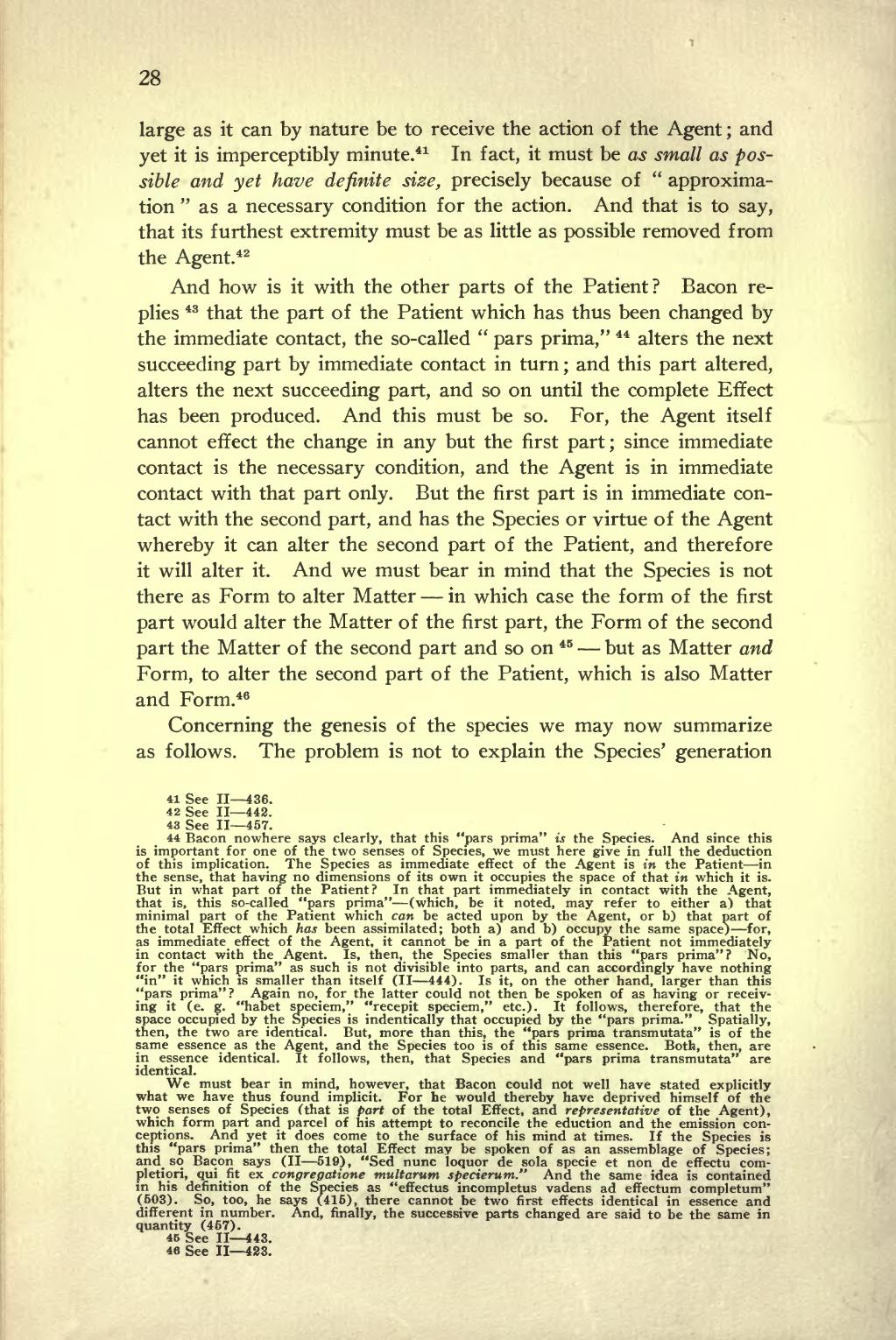large as it can by nature be to receive the action of the Agent; and yet it is imperceptibly minute.[1] In fact, it must be as small as possible and yet have definite size, precisely because of “approximation” as a necessary condition for the action. And that is to say, that its furthest extremity must be as little as possible removed from the Agent.[2]
And how is it with the other parts of the Patient? Bacon replies[3] that the part of the Patient which has thus been changed by the immediate contact, the so-called “pars prima,”[4] alters the next succeeding part by immediate contact in turn; and this part altered, alters the next succeeding part, and so on until the complete Effect has been produced. And this must be so. For, the Agent itself cannot effect the change in any but the first part; since immediate contact is the necessary condition, and the Agent is in immediate contact with that part only. But the first part is in immediate contact with the second part, and has the Species or virtue of the Agent whereby it can alter the second part of the Patient, and therefore it will alter it. And we must bear in mind that the Species is not there as Form to alter Matter—in which case the form of the first part would alter the Matter of the first part, the Form of the second part the Matter of the second part and so on[5]—but as Matter and Form, to alter the second part of the Patient, which is also Matter and Form.[6]
Concerning the genesis of the species we may now summarize as follows. The problem is not to explain the Species’ generation
- ↑ See II—436.
- ↑ See II—442.
- ↑ See II—457.
- ↑ Bacon nowhere says clearly, that this "pars prima" is the Species. And since this is important for one of the two senses of Species, we must here give in full the deduction of this implication. The Species as immediate effect of the Agent is in the Patient—in the sense, that having no dimensions of its own it occupies the space of that in which it is. But in what part of the Patient? In that part immediately in contact with the Agent, that is, this so-called "pars prima"—(which, be it noted, may refer to either a) that minimal part of the Patient which can be acted upon by the Agent, or b) that part of the total Effect which has been assimilated; both a) and b) occupy the same space)—for, as immediate effect of the Agent, it cannot be in a part of the Patient not immediately in contact with the Agent. Is, then, the Species smaller than this "pars prima"? No, for the "pars prima" as such is not divisible into parts, and can accordingly have nothing "in" it which is smaller than itself (II—444). Is it, on the other hand, larger than this "pars prima"? Again no, for the latter could not then be spoken of as having or receiving it (e.g. "habet speciem," "recepit speciem," etc.). It follows, therefore, that the space occupied by the Species is indentically that occupied by the "pars prima." Spatially, then, the two are identical. But, more than this, the "pars prima transmutata" is of the same essence as the Agent, and the Species too is of this same essence. Both, then, are in essence identical. It follows, then, that Species and "pars prima transmutata" are
identical.
We must bear in mind, however, that Bacon could not well have stated explicitly what we have thus found implicit. For he would thereby have deprived himself of the two senses of Species (that is part of the total Effect, and representative of the Agent), which form part and parcel of his attempt to reconcile the eduction and the emission conceptions. And yet it does come to the surface of his mind at times. If the Species is this "pars prima" then the total Effect may be spoken of as an assemblage of Species; and so Bacon says (II—519), "Sed nunc loquor de sola specie et non de effectu completion, qui fit ex congregatione multarum specierum." And the same idea is contained in his definition of the Species as "effectus incompletus vadens ad effectum completum" (503). So, too, he says (415), there cannot be two first effects identical in essence and different in number. And, finally, the successive parts changed are said to be the same in quantity (457).
- ↑ See II—443.
- ↑ See II—423.
